Sleepy Kep. Kep Sur Mer. The quiet little town on Cambodia’s coast famous for its crab market, accessible national park, and the graffitied shells of luxury 1960s villas destroyed by the Khmer Rouge. Kep, the coastal alternative to nearby Kampot, with fewer restaurants but better-value accommodation set among trees and colorful bougainvillea. The Kep of breath-taking sunsets at The Sailing Club, with the sea breeze and lapping waves a constant reminder that one isn’t in Phnom Penh anymore.
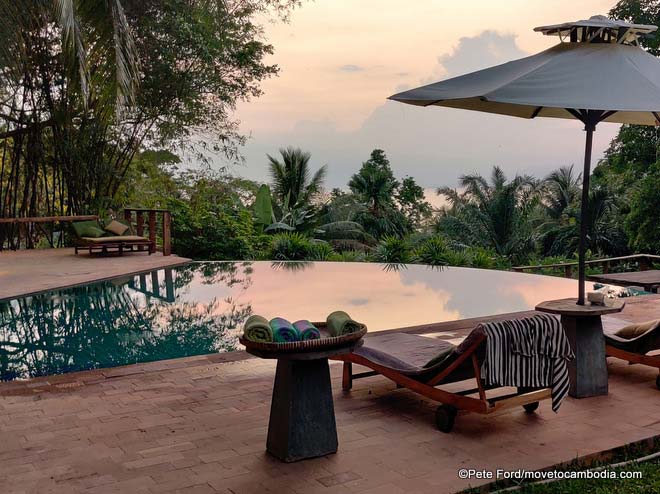
Luxury at Kep’s Villa Des Palmes is just like the old days.
That Kep is now largely gone and is being rapidly replaced by a new Kep; less tailored to expats and Western visitors and more accessible to local tourists, a Kep that in time might be just as charming as the previous iteration.
Everywhere changes, and change can often be good, offering improvements in standing of living and employment, and may even improve environmental conditions such as clean water or waste management. However, rapid change can be scary, and the lack of transparency in Kep about plans, intentions, and environmental impact doesn’t inspire confidence.
And the speed at which Kep is changing is truly breakneck.
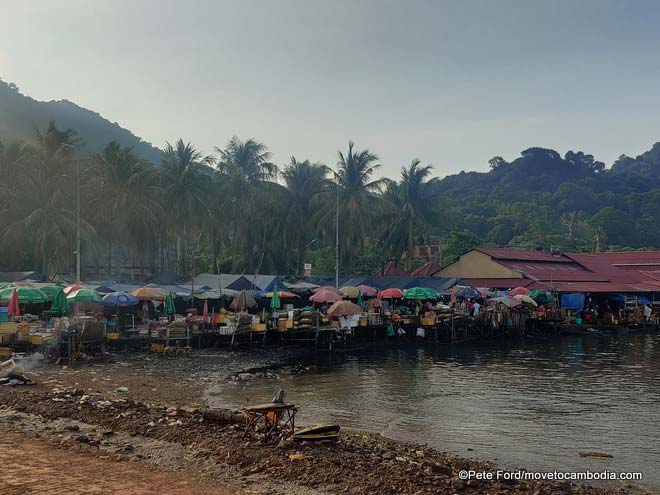
The new Kep crab market.
The area of coast north of the crab market, once rocky and dotted with mangroves—long denuded of the seagrass beds that had been home to Kep’s famous shrimp and crab—now lies buried under rubble after months of work. Some 300 meters of sea has been ‘reclaimed’ from the coast, stretching seemingly endlessly northwards. This will apparently form a new beach area with promenade, and greatly expand the coastal activities available in Kep which were previously limited to the old beach further along the coast, itself a man-made creation decades earlier.
With gray sand being dredged from further into the bay to create the new beach, it is hard to imagine that the Kep beach will become the beautiful tourist attraction it is intended to be. Yet it might not be too long from now that new visitors to Kep delight in what has been created, but at what environmental cost? While the environmental impact is still unknown, it is clear the project further stresses Cambodia’s ravaged coastal ecosystem.
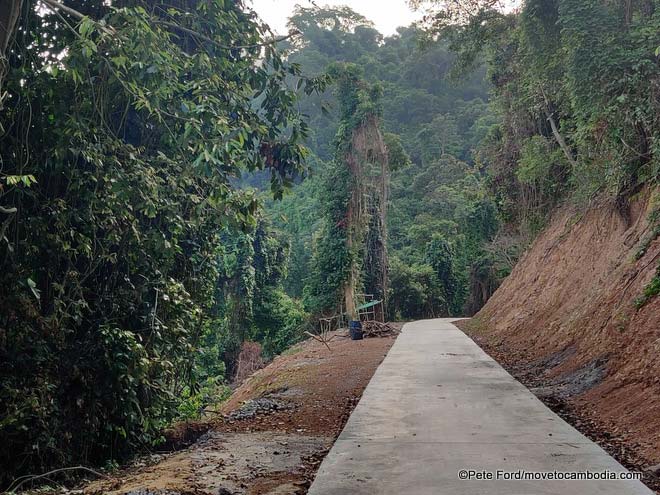
Kep National Park is now more accessible.
There are also changes elsewhere. The bumpy, rocky trail leading to the fantastic 3-hour loop of Kep National Park has been paved. Possibly Cambodia’s most accessible walking trail, it offers stunning views of distant Kampot and Vietnam’s Phu Quoc island. The verdant greenery and various birdsong has long offered an easy access to the outdoors that so many visitors to Cambodia miss.
And all of this is of course still available. The smooth concrete surface is thankfully too narrow for cars, but it is now a much less daunting surface for novice cyclists or walkers. If this encourages more Cambodians to explore the park—which previously felt like the preserve of foreign tourists only—beyond the popular Insta-friendly Led Zep cafe near its main entrance, then the new surface will have been a success.
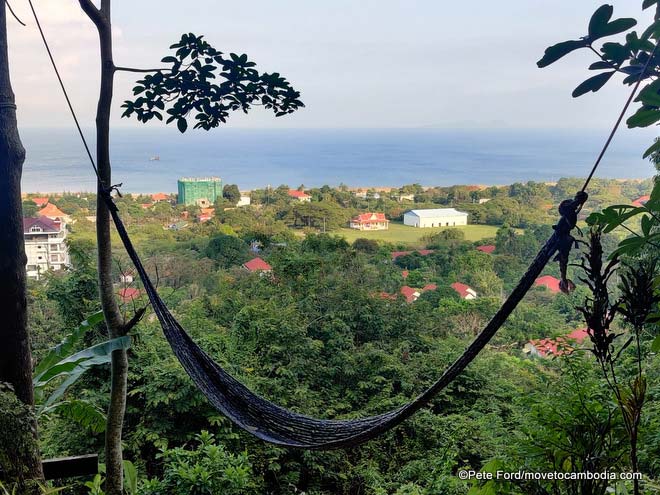
More and more giant hotels are springing up around Kep.
Other changes to Kep are more visibly obvious. At least three giant hotel complexes are in various stages of completion. Larger even than anything in the much busier Kampot, they starkly contrast with Kep’s existing mix of small guesthouses and bungalow resorts. If these new hotels ever fill with guests, the new beach area will be needed just to give everyone somewhere to go, as the old beach is already filled to capacity during Cambodian holidays.
Less visible from the coast, Rabbit Island, a short boat ride away, is being subjected to a casino resort owned by the man often cited as responsible for much of Cambodia’s deforestation, and the low-key beach bungalows might be slightly less peaceful, if they survive at all.
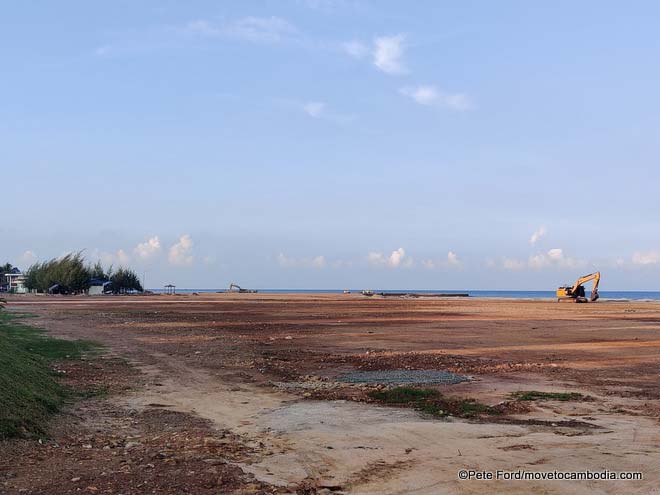
Kep’s current iteration. But what’s next?
So for anyone who has previously visited Kep, a return visit now will be a shock. For anyone who visits for the first time (in about 6 months time once the reclamation project is mostly finished) you might still enjoy your stay, complete with extra hotel options, and a national park that grandparents or small children in a pushchair can also now enjoy.
The old Kep is dead. Lets see what new Kep grows to become.
The reporting above on Kep accurate..I have lived here for five years. I love the place and loved it more during the pandemic..I virtually had it all to myself..
Sadly as stated above it is undergoing massive changes..
The quaintness will soon be gone.
I’m sure it will bring prosperity and employment. Progress we can’t stop.
I’m selfish for the old kep..but I wll embrace the new.
I was there 2 weeks ago theres alot going on but still good place to go
I got to see Kep in 2019 and lots of changes were already in progress. Probably won’t recognize it when I return.
Same thing Sukanville Cambodia was destroyed by the Chinese developers.Along with Thailands Koh Phagon Saumi .
Yet another missed opportunity with wonton over development and destruction.
Yes, the old Kep is undergoing cosmetic surgery at a massive scale, but it is still blessed with an incredible sunset. And the paved promenade around the National Park is indeed an improvement over the old dirt (and often muddy) road. I can attest that many more people now enjoy that walk as well as the wondrous elevated views over the coast and Kampot. The hotels are there but the staff still needs training and the day-trippers from Phnom Penh still need to learn how to be “green” tourists. Apart from the food, the sun, the sights and the beach, Kep still lacks cultural activities and buildings to accommodate them. The only “cultural” monument, the Kep movie theater, is a relic from the past. It sits hidden near the main market, an empty carcass in ruin that saw better days before the war. Now that the infrastructure is rapidly falling into place, let’s hope that cultural buildings will follow. Let’s hope also that sleepy Kep will not turn into a 2 mile-long Karaoke street where spirit-imbibed wanna-be Sisamuth bawl songs at ear-shattering loudness that the Kep hillside reverberates in the dead of night. Sleepless in Kep. Let’s hope that the municipally writes and enforces a noise ordinance to keep Kep quiet at night. I suppose it wants the tourists to spend the night in the local hotels. Day trippers are fine, but hotel guests are better for the local economy.
They turned Snooky into a Stalinist architect’s fever dream. I’ll never go back. It sounds like Kep is going the same way. That’s a real shame – it’s one of the first places I took Yim after we married and I’ve got fond memories of the place.
Agree with John. In 2016/17 Kep was truly wonderful and unspoilt by the usual waves of bling tourists. Hope it will retain its charm and not go the way Phuket did !
Wow. I hope it doesn’t get destroyed like Sihanoukville. Time will tell.
Have they made it easier to go without a covid vaccination and now what about the Monkeypox??